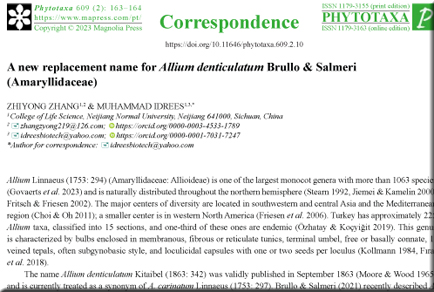Abstract
Allium Linnaeus (1753: 294) (Amaryllidaceae: Allioideae) is one of the largest monocot genera with more than 1063 species (Govaerts et al. 2023) and is naturally distributed throughout the northern hemisphere (Stearn 1992, Jiemei & Kamelin 2000, Fritsch & Friesen 2002). The major centers of diversity are located in southwestern and central Asia and the Mediterranean region (Choi & Oh 2011); a smaller center is in western North America (Friesen et al. 2006). Turkey has approximately 225 Allium taxa, classified into 15 sections, and one-third of these ones are endemic (Özhatay & Koçyiğit 2019). This genus is characterized by bulbs enclosed in membranous, fibrous or reticulate tunics, terminal umbel, free or basally connate, 1-veined tepals, often subgynobasic style, and loculicidal capsules with one or two seeds per loculus (Kollmann 1984, Fırat et al. 2018).
References
- Brullo, S. & Salmeri, C. (2021) Taxonomic investigation on Allium hirtovaginum group (Amaryllidaceae) from East Mediterranean area. Flora Mediterranea 31 (Special Issue): 169–211. https://doi.org/10.7320/FlMedit31SI.169
- Choi, H.J. & Oh, B.U. (2011) A partial revision of Allium (Amaryllidaceae) in Korea and north-eastern China. Botanical Journal of the Linnean Society 167: 153–211. https://doi.org/10.1111/j.1095-8339.2011.01166.x
- Fırat, M., Koyuncu, M. & Ekşi, G. (2018) Allium pervariensis, sect. Allium (Amaryllidaceae), a new species from Siirt Turkey. Plant Biosystems 152: 305–310. https://doi.org/10.1080/11263504.2016.1271051
- Friesen, N., Fritsch, R.M. & Blattner, F.R. (2006) Phylogeny and new intrageneric classification of Allium (Alliaceae) based on nuclear ribosomal DNA ITS sequences. Aliso 22: 372–395. https://doi.org/10.5642/aliso.20062201.31
- Fritsch, R.M. & Friesen, N. (2002) Evolution, domestication, and taxonomy. In: Rabinowitch, H.D. & Currah, L. (Eds.) Allium Crop Science: Recent Advances. Wallinford, pp. 5–30. https://doi.org/10.1079/9780851995106.0005
- Govaerts, R., Kington, S., Friesen, N., Fritsch, R., Snijman, D.A., Marcucci, A., Silverstone-Sopkin, P.A. & Brullo, S. (2023) Worldchecklist of Amaryllidaceae. Facilitated by the Royal Botanic Gardens, Kew. Available from: http://apps.kew.org/wcsp/ (accessed 20 April 2023)
- Jiemei, X. & Kamelin, R.V. (2000) Allium Linnaeus. In: Zhengyi, W., Raven, P.H. & Deyuan, H. (Eds.) Flora of China 24. Science Press, Missouri Botanical Garden, Beijing, St. Louis, pp. 165–202.
- Kitaibel, P. (1863–1864) Additamenta ad Floram Hungaricam. Linnaea: Ein Journal für die Botanik in ihrem ganzen Umfange 32: 305–642. [page 342 was published in September 1863] Available from: https://www.biodiversitylibrary.org/page/118425 (accessed 21 August 2023)
- Kollmann, F. (1984) Allium L. In: Davis, P.H. (Ed.) Flora of Turkey and the East Aegean Islands 8. Edinburgh University Press, Edinburgh, pp. 98–211.
- Linnaeus, C. (1753) Species Plantarum. Impensis Laurentii Salvii, Holmiae, Stockholm, 1200 pp. https://doi.org/10.5962/bhl.title.669
- Moore, H.E. & Wood, C.E. (1965) Dates of publication of the journal Linnaea: further evidence. Journal of the Arnold Arboretum 46: 68–73. Available from: https://www.biodiversitylibrary.org/item/39781#page/74/mode/1up (accessed 21 August 2023)
- Mössler, J.C. (1827) Gemeinnütziges Handbuch der Gewächskunde. Ed. 2, 1. J.F. Hammerich, Altona, 784 pp.
- Özhatay, N. & Koçyiğit, M. (2019) A checklist of Turkish Allium species, with taxonomic assessments: Allium sect. Allium, sect. Codonoprasum and sect. Scorodon. Botanika Chronika 22: 73–85.
- Stearn, W.T. (1992) How many species of Allium are known? Kew Magazine 9: 180–182.
- Turland, N.J., Wiersema, J.H., Barrie, F.R., Greuter, W., Hawksworth, D.L., Herendeen, P.S., Knapp, S., Kusber, W.-H., Li, D.-Z., Marhold, K., May, T.W., McNeill, J., Monro, A.M., Prado, J., Price, M.J. & Smith, G.F. (Eds.) (2018) International Code of Nomenclature for algae, fungi, and plants (Shenzhen Code) adopted by the Nineteenth International Botanical Congress Shenzhen, China, July 2017. Regnum Vegetabile 159. Koeltz Botanical Books, Glashütten, 254 pp. https://doi.org/10.12705/Code.2018


